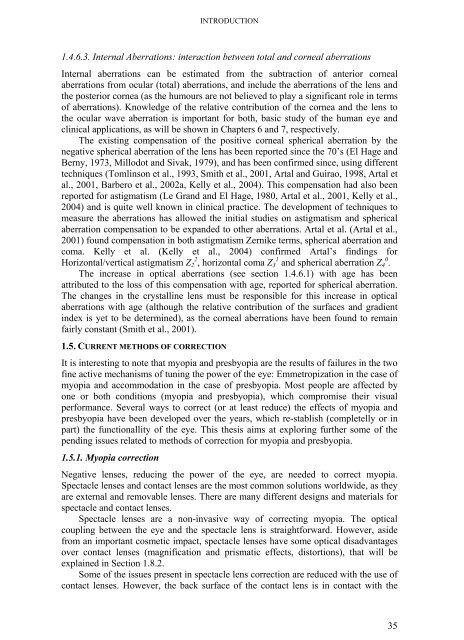Low_resolution_Thesis_CDD_221009_public - Visual Optics and ...
Low_resolution_Thesis_CDD_221009_public - Visual Optics and ...
Low_resolution_Thesis_CDD_221009_public - Visual Optics and ...
You also want an ePaper? Increase the reach of your titles
YUMPU automatically turns print PDFs into web optimized ePapers that Google loves.
INTRODUCTION<br />
1.4.6.3. Internal Aberrations: interaction between total <strong>and</strong> corneal aberrations<br />
Internal aberrations can be estimated from the subtraction of anterior corneal<br />
aberrations from ocular (total) aberrations, <strong>and</strong> include the aberrations of the lens <strong>and</strong><br />
the posterior cornea (as the humours are not believed to play a significant role in terms<br />
of aberrations). Knowledge of the relative contribution of the cornea <strong>and</strong> the lens to<br />
the ocular wave aberration is important for both, basic study of the human eye <strong>and</strong><br />
clinical applications, as will be shown in Chapters 6 <strong>and</strong> 7, respectively.<br />
The existing compensation of the positive corneal spherical aberration by the<br />
negative spherical aberration of the lens has been reported since the 70’s (El Hage <strong>and</strong><br />
Berny, 1973, Millodot <strong>and</strong> Sivak, 1979), <strong>and</strong> has been confirmed since, using different<br />
techniques (Tomlinson et al., 1993, Smith et al., 2001, Artal <strong>and</strong> Guirao, 1998, Artal et<br />
al., 2001, Barbero et al., 2002a, Kelly et al., 2004). This compensation had also been<br />
reported for astigmatism (Le Gr<strong>and</strong> <strong>and</strong> El Hage, 1980, Artal et al., 2001, Kelly et al.,<br />
2004) <strong>and</strong> is quite well known in clinical practice. The development of techniques to<br />
measure the aberrations has allowed the initial studies on astigmatism <strong>and</strong> spherical<br />
aberration compensation to be exp<strong>and</strong>ed to other aberrations. Artal et al. (Artal et al.,<br />
2001) found compensation in both astigmatism Zernike terms, spherical aberration <strong>and</strong><br />
coma. Kelly et al. (Kelly et al., 2004) confirmed Artal’s findings for<br />
Horizontal/vertical astigmatism Z 2 2 , horizontal coma Z 1 3 <strong>and</strong> spherical aberration Z 0 4 .<br />
The increase in optical aberrations (see section 1.4.6.1) with age has been<br />
attributed to the loss of this compensation with age, reported for spherical aberration.<br />
The changes in the crystalline lens must be responsible for this increase in optical<br />
aberrations with age (although the relative contribution of the surfaces <strong>and</strong> gradient<br />
index is yet to be determined), as the corneal aberrations have been found to remain<br />
fairly constant (Smith et al., 2001).<br />
1.5. CURRENT METHODS OF CORRECTION<br />
It is interesting to note that myopia <strong>and</strong> presbyopia are the results of failures in the two<br />
fine active mechanisms of tuning the power of the eye: Emmetropization in the case of<br />
myopia <strong>and</strong> accommodation in the case of presbyopia. Most people are affected by<br />
one or both conditions (myopia <strong>and</strong> presbyopia), which compromise their visual<br />
performance. Several ways to correct (or at least reduce) the effects of myopia <strong>and</strong><br />
presbyopia have been developed over the years, which re-stablish (completelly or in<br />
part) the functionallity of the eye. This thesis aims at exploring further some of the<br />
pending issues related to methods of correction for myopia <strong>and</strong> presbyopia.<br />
1.5.1. Myopia correction<br />
Negative lenses, reducing the power of the eye, are needed to correct myopia.<br />
Spectacle lenses <strong>and</strong> contact lenses are the most common solutions worldwide, as they<br />
are external <strong>and</strong> removable lenses. There are many different designs <strong>and</strong> materials for<br />
spectacle <strong>and</strong> contact lenses.<br />
Spectacle lenses are a non-invasive way of correcting myopia. The optical<br />
coupling between the eye <strong>and</strong> the spectacle lens is straightforward. However, aside<br />
from an important cosmetic impact, spectacle lenses have some optical disadvantages<br />
over contact lenses (magnification <strong>and</strong> prismatic effects, distortions), that will be<br />
explained in Section 1.8.2.<br />
Some of the issues present in spectacle lens correction are reduced with the use of<br />
contact lenses. However, the back surface of the contact lens is in contact with the<br />
35











